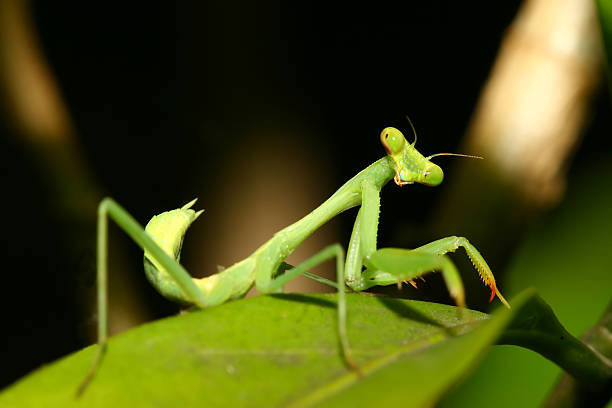Do female praying mantis really eat their males?

Praying mantises are a group of over 2,400 species that live in tropical and temperate climates across the world. They have the appearance of actual Terminators. Their eyes are open, and they have a shaky gait or a head that turns 180 degrees on a lengthy neck. Everyone is conscious of the fact that the female praying mantis often consumes the male after copulation. Everyone is conscious of the fact that the female praying mantis often devours the male after copulation.
Predators with great strength

Praying mantises may be as little as 3 centimeters long or as large as 30 centimeters. Smaller species have a lifespan of 4 to 6 months, whereas larger species have a lifespan of 4 to 8 weeks. The majority of them are green, brown, or pink in hue. Praying mantises have excellent camouflage to blend in with the surrounding vegetation.
Whether you’re wondering if a praying mantis in the wild is hazardous, the answer is no. Praying mantises can’t sting and have no venom. Worms, various insects, fish, and even tiny birds are among their favorite foods. Praying mantises are adaptable predators with a distinct hunting strategy.
For a variety of reasons, praying mantises may relax and wait for their meal. First, they have a movable head with a highly developed visual system. All predators must estimate the size of their prey before rushing at it; otherwise, time and energy will be wasted, and the predator’s power balance may shift, and the predator may become prey.
Amazing Mantis sighting

“While pursuing predators can estimate the size of their prey based on its size and speed of movement, praying mantises must make split-second choices since they are not chasing their prey.” As a result, they have two forward-facing eyes and a flexible neck akin to an owl’s. They can look in practically any direction with their eyes. The praying mantis, like humans, triangulates and estimates the size and location of the item once it is seen.
The eyes of praying mantis aren’t that dissimilar to ours, at least in terms of how they work. They, like humans, employ stereopsis, which is the capacity to observe the world in three dimensions and compare pictures with two eyes to comprehend what they are seeing. This has always piqued scientists’ interest, and it has long been the subject of praying mantises study.
“The fundamental idea was that these animals’ visual systems were complicated, but their motor orders for catching prey were simple. “The assault was deemed typical after the prey was visually appraised in the intended section of the space.” Early research even claimed that it may be ballistic, similar to a chameleon’s throwing tongue and that it is carried out automatically once began.”
In other words, scientists believe that the praying mantis’ eyes conduct the majority of the work and that the animal is oblivious to its activities when the eyes provide commands to the body.
Study reveals that the mantis assault is significantly more complex than previously thought”. The praying mantis can convert the visual picture of an approaching prey into a perfectly timed motor program that allows it to catch it. Praying mantises retain a watch on their target during their assault, as indicated by their ability to suspend their attack. In the worst-case scenario, they may refuse to strike at all if they begin striking too late. Given how quick the assaults are, the fact that their nervous systems can do these computations and recognize their errors is awe-inspiring.
Cockroach cousins to praying mantises

Even among their near cousins, mantises are one-of-a-kind. Praying mantises are surrounded by non-predatory cousins, as can be seen in the insect family tree. Cockroaches are their closest living cousins. Adult mantises have wings, similar to cockroaches. Males, in contrast to females, can generally fly. Stick insects, crickets, and grasshoppers are all closely related to them.
This shows they may have evolved as predators due to specific characteristics. Consequently, the praying mantis has become an essential species in determining which features are necessary for predation and which are the product of a predator group’s evolutionary restrictions.
And, since you’re probably already itching to learn the truth about mantis devouring their male, here’s everything you need to know:
“What people don’t realize is that this only occurs when the female is hungry and requires a lot of energy to grow the eggs,” Rossoni Sergio explains. It’s also been established that if a male is exposed to the smell of many females, he will attempt to flee as soon as possible after copulation to avoid being eaten. If a male is only exposed to one female, on the other hand, he will remain after copulation so that the female may consume him. He prefers being devoured to escaping and dying alone because it gives him a higher chance of producing progeny.
While walking and swinging, praying mantises sometimes shake. They do this to seem like waving leaves in the breeze.




